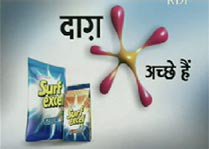Company:Ford India
Agency:JWT
Brand Count:208
 . Ford came to India with a dated model like Ford Escort.Escort was launched in 1995 and was one of the first international brand to enter the midsize sedan market.
. Ford came to India with a dated model like Ford Escort.Escort was launched in 1995 and was one of the first international brand to enter the midsize sedan market.Ford Ikon was launched in the event of phasing out of Escort. Since then Ikon has been a major player in the entry level sedan market with a share of over 20%. The most interesting aspect of the brand is in its positioning. Ikon dethroned the position of Esteem in the C segment through its breakaway positioning.
Till 2005 Ikon has sold over 100,000 cars and has occupied a special space in the highly competitive car market in India. Ford Ikon is actually an Indian adaptation of the highly successful European Fiesta model. But knowing the Indian market with the Escort example, the company decided to design and Indian car for Indian consumers. Thus born the brand Ikon.
The company virtually adapted the whole product to suit the Indian consumer taste and also Indian driving conditions.Ikon was one of the first examples of Global brand getting Local in the automotive industry.
Once the product is ready, came the question of marketing. Ikon was priced as an entry level sedan car and was positioned in the C segment. C segment was dominated by Esteem and there was a slew of competitors waiting to tap the market including Hyundai Accent. Most of the purchases in this segment was rational and the brands were also positioned on rational platforms. Ikon wanted to break the icons and decided to do away with the demographic positioning. Research and initial test marketing showed that Ikon is associated with the Attractive and Peppy attributes. The company decided to position the brand as a lifestyle brand. The TG was decided to be young professionals who works hard and play hard who are Full of Life and Affluent. This brand is the classic case of lifestyle segmentation.
Ikon had the sporty design and all the pep that a sporty car needs interms of engine capacity and performance. The agency hit upon the big idea of positioning the brand as the Josh Machine.I think the tagline JOSH Machine is one of the best taglines I have come across
 . Although the term Josh is hindi ( I have criticised Go Fida campaign) Josh term had a universal appeal across India. Although some of the ads were lousy, the product delivered the promise. The Brand clearly identified the TG and Josh satisfied the need for a sporty sedan ( that need is still there). Indian Yuppies lapped up this product and the brand which suffered most because of Ikon was the Maruti Esteem.Ikon was priced between Rs 5.5 lakh and 6 lakhs.The brand broke from the rational positioning into a more emotional plane.The brand had the famous tagline " The Josh Machine " which was later modified to " Live Life with Josh".
. Although the term Josh is hindi ( I have criticised Go Fida campaign) Josh term had a universal appeal across India. Although some of the ads were lousy, the product delivered the promise. The Brand clearly identified the TG and Josh satisfied the need for a sporty sedan ( that need is still there). Indian Yuppies lapped up this product and the brand which suffered most because of Ikon was the Maruti Esteem.Ikon was priced between Rs 5.5 lakh and 6 lakhs.The brand broke from the rational positioning into a more emotional plane.The brand had the famous tagline " The Josh Machine " which was later modified to " Live Life with Josh".The brand hit a rough patch in 2003 with competition hotting up. The launch of Indigo changed the dynamics of the C segment. To compete with Indigo, Ikon launched a variant in the sub 5 lakh category with Ford Flair.
Last year Ford launched its Fiesta in the Indian market at a premium over Ikon. According to company reports, Fiesta is positioned as an Aspirational sedan and complements Ikon rather than cannibalise it. Fiesta became a runaway success because of its blockbuster performance.
Ford Ikon is now at a critical point in its lifecycle. Although the brand has came out with lot of variants over time like SXI, NXT, the brand is now perceived to be an old brand.The Josh in this brand is no longer there and the company is now focusing on its new baby Fiesta. This lack of marketing and brand building on Ikon can prove to be a big negative for the brand. Slowly the brand may lose its relevance in the Indian market . The Ford India site talks about the new Ford Ikon with spruced up interiors,but what the brand needs is a relook on the promotional front.The brand still holds significant relevance in the Indian market because there is no brand that has the sporty look and the positioning of Ikon. There is still an unmet need for a peppy car and Ikon if not promoted with Josh will be a great injustice to the brand. There is not even a need for repositioning. Only high profile well made advertisements will do the trick. Exciting colors and roadshows will pep up this sagging brand. Else this brand will die a very untimely and unwarranted death..
Source: Businessline,agencyfaqs,
image courtesy: agencyfaqs,ford website
Related brand
Ford Fiesta





















